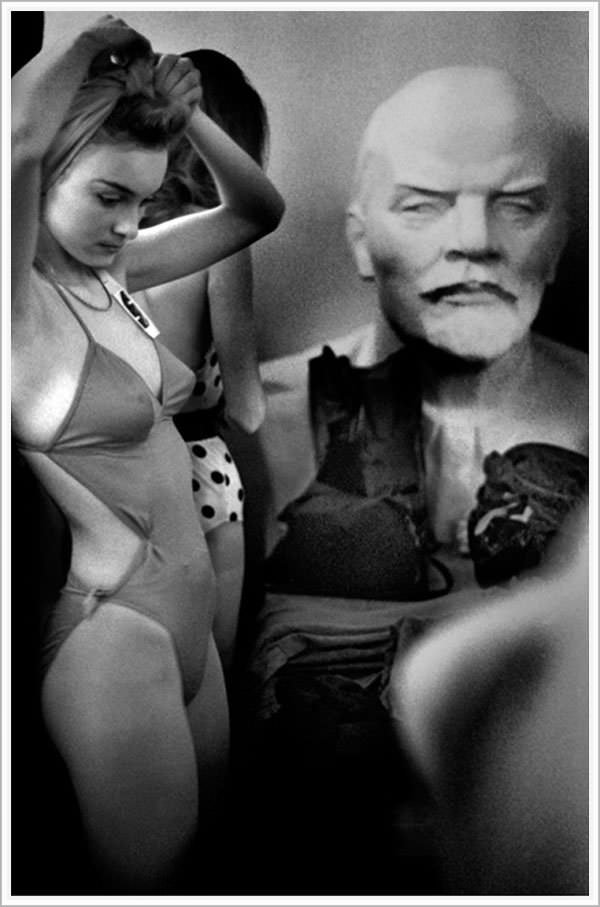
Contestants getting ready for the Miss Soviet Union pageant near a statue of Vladimir Lenin in Moscow, USSR in 1988. This is the first beauty pageant of any kind in the Soviet Union since they were banned in 1959. The USSR had a history of rather conservative views, outlawing anything they deemed too much for long stretches before they collapsed. This included provocative attire or even certain Western clothing, homosexuality, dance and strip clubs, pornography, and plenty more. In the 1980s the USSR removed some of those restrictions, such as beauty pageants. After the collapse and transition to democracy, much more would be allowed throughout Russia and the many countries created afterwards.

3 Children on their way to school in Oklahoma, US in 1933. This was during the terrible time know as The Dust Bowl, when storms ravaged the area in the 1930s. The storms were saw bad, people could not venture outside without wearing protection. This also heavily affected farming and gave people health issues as well, with some cases causing deaths. Severe drought and a failure to apply dryland farming methods know as the Aeolian process which would prevent wind erosion caused the phenomenon. The key areas affected were parts of Oklahoma, Texas, New Mexico, Colorado and half of Kansas. Poor families in particular had to abandon their homes and land entirely, as they couldn't grow anything and could not pay their mortgages. This was also during the Great Depression, leaving little other options for work in the affected areas. In the 1930s, it is estimated 3.5 million people moved out of the plain states, many to California.

22 Year old SS guard of the Auschwitz concentration camp Irma Ilse defiantly poses for a picture after her capture in 1945. She was also the warden of the womens section of the Bergen-Belsen concentration camp. Many said she had the face of pure evil and showed zero remorse for her crimes which included executions, assisting with Nazi experiments, torture, beatings, and much more. Originally she wanted to be a nurse, but she failed all her tests. She became infatuated with the Nazi's and volunteered for SS guard duty. She went from wanting to try to save people to killing them. She would be hung for war crimes later that year.

A female rebel soldier known as a Soldadera in Mexico in 1911. During the Mexican revolution, women and children were heavily involved in the revolutionary army. In the beginning, the US supported the Mexican government, and made it more difficult for the revolutionaries to get supplies and men for the fight. So they grabbed anyone willing to fight or whom they could force/trick into fighting. Women, children as young as 8, anyone. They also began a campaign of attacking armories, including US armories for supplies. After about 4 years, the US actually switched sides, and supported the rebels, changing the dynamics of the war. The US even sent troops into Mexico to fight. A major country so close able to supply the rebels gave them the upper hand, and in 1920, after nearly 10 years of war, the revolutionaries won. An interesting note about the US involvement in Mexico; during WWI, Germany knew the US joining the allies was a big problem for them. They contacted the Mexican government and asked them to join the German side, going to war with the US, and once they won, Mexico would receive all lost lands from the US including parts of Arizona, New Mexico, California, and of course Texas. The US actually uncovered this plan before Mexico had made a decision. With their own problems, the Mexican government was not crazy and desperate enough to join the Germans and go to war against the US anyway.

Soldiers on watch to prevent looting after the Great Boston Fire in 1872. The fire began in a commercial buildings basement. It moved incredibly fast, and it destroyed 776 buildings over 65 acres in just 12 hours. Much of the financial district was burned to the ground, costing $73.5 million in damage (that's $1.5 billion today). The timing and fast action did prevent deaths, as only 13 people died in the blaze, but no city authority existed at the time to enforce building codes, meaning many of the buildings were old and prone to fire. As with many protection measures in the US, a major avoidable disaster has to take place before action is actually taken.